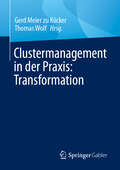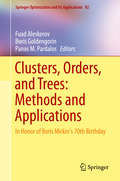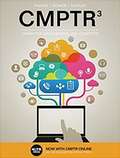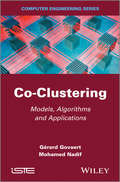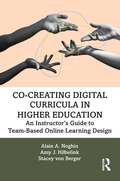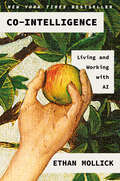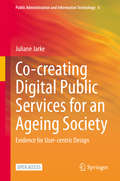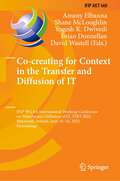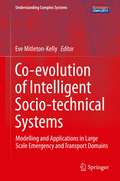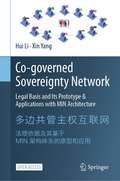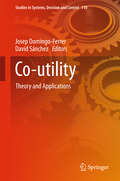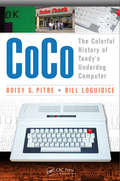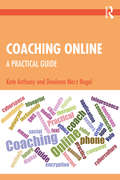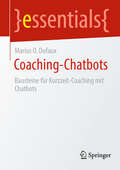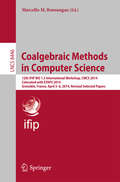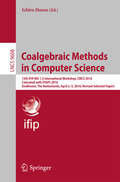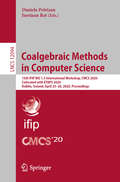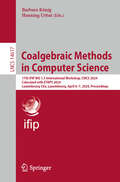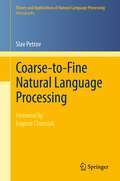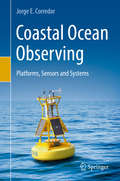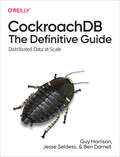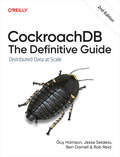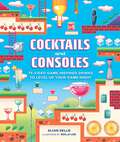- Table View
- List View
Clustermanagement in der Praxis: Transformation
by Thomas Wolf Gerd Meier zu KöckerIn der regionalen Wirtschaftsentwicklung nehmen Clusterinitiativen eine große Bedeutung ein, gerade wenn es um die Steigerung von Innovationskraft bei kleineren und mittleren Unternehmen geht. Doch wie lassen sich Clusterinitiativen sinnvoll als Instrument in die Regionalentwicklung einbetten und wie kann gutes Clustermanagement als zentrale Schlüsselfunktion aussehen, damit die Netzwerke ihr volles Potenzial entfalten können? In den letzten Jahren gab es vermehrt gelungene Beispiele dafür, wie Clusterinitiativen Mehrwerte im Sinne ihrer Akteure generieren können. Dieses Buch stellt erfolgreiche Transformationen von Clusterinitiativen vor und gibt einen Überblick über die Chancen und Herausforderungen im täglichen Geschäft. Es bietet eine praxisorientierte Hilfestellung und viele Best-Practice-Beispiele speziell für Clustermanager, aber auch für Wirtschaftsförderungen, Kommunen, Verwaltung, Unternehmen, Wissenschaft, Verbände und Vereine.
Clusters, Orders, and Trees: In Honor of Boris Mirkin's 70th Birthday (Springer Optimization and Its Applications #92)
by Panos M. Pardalos Boris Goldengorin Fuad AleskerovThe volume is dedicated to Boris Mirkin on the occasion of his 70th birthday. In addition to his startling PhD results in abstract automata theory, Mirkin's ground breaking contributions in various fields of decision making and data analysis have marked the fourth quarter of the 20th century and beyond Mirkin has done pioneering work in group choice, clustering, data mining and knowledge discovery aimed at finding and describing non-trivial or hidden structures--first of all, clusters, orderings and hierarchies--in multivariate and/or network data. This volume contains a collection of papers reflecting recent developments rooted in Mirkin's fundamental contribution to the state-of-the-art in group choice, ordering, clustering, data mining and knowledge discovery. Researchers, students and software engineers will benefit from new knowledge discovery techniques and application directions.
Cmptr³: Computer Applications and Concepts
by Katherine T. Pinard Robin M. Romer Deborah MorleyCMPTR's easy-reference, paperback book presents course content through visually engaging chapters as well as Chapter Review Cards that consolidate the most important material into a ready-made study tool. CMPTR introduces the latest updates in Microsoft Office, including Windows 10, Edge web browser, and Office 2016 applications with fun facts, tips, and walk-through videos.
Co-Clustering: Models, Algorithms and Applications (Focus Ser.)
by Gérard Govaert Mohamed NadifCluster or co-cluster analyses are important tools in a variety of scientific areas. The introduction of this book presents a state of the art of already well-established, as well as more recent methods of co-clustering. The authors mainly deal with the two-mode partitioning under different approaches, but pay particular attention to a probabilistic approach. Chapter 1 concerns clustering in general and the model-based clustering in particular. The authors briefly review the classical clustering methods and focus on the mixture model. They present and discuss the use of different mixtures adapted to different types of data. The algorithms used are described and related works with different classical methods are presented and commented upon. This chapter is useful in tackling the problem of co-clustering under the mixture approach. Chapter 2 is devoted to the latent block model proposed in the mixture approach context. The authors discuss this model in detail and present its interest regarding co-clustering. Various algorithms are presented in a general context. Chapter 3 focuses on binary and categorical data. It presents, in detail, the appropriated latent block mixture models. Variants of these models and algorithms are presented and illustrated using examples. Chapter 4 focuses on contingency data. Mutual information, phi-squared and model-based co-clustering are studied. Models, algorithms and connections among different approaches are described and illustrated. Chapter 5 presents the case of continuous data. In the same way, the different approaches used in the previous chapters are extended to this situation. Contents 1. Cluster Analysis. 2. Model-Based Co-Clustering. 3. Co-Clustering of Binary and Categorical Data. 4. Co-Clustering of Contingency Tables. 5. Co-Clustering of Continuous Data. About the Authors Gérard Govaert is Professor at the University of Technology of Compiègne, France. He is also a member of the CNRS Laboratory Heudiasyc (Heuristic and diagnostic of complex systems). His research interests include latent structure modeling, model selection, model-based cluster analysis, block clustering and statistical pattern recognition. He is one of the authors of the MIXMOD (MIXtureMODelling) software. Mohamed Nadif is Professor at the University of Paris-Descartes, France, where he is a member of LIPADE (Paris Descartes computer science laboratory) in the Mathematics and Computer Science department. His research interests include machine learning, data mining, model-based cluster analysis, co-clustering, factorization and data analysis. Cluster Analysis is an important tool in a variety of scientific areas. Chapter 1 briefly presents a state of the art of already well-established as well more recent methods. The hierarchical, partitioning and fuzzy approaches will be discussed amongst others. The authors review the difficulty of these classical methods in tackling the high dimensionality, sparsity and scalability. Chapter 2 discusses the interests of coclustering, presenting different approaches and defining a co-cluster. The authors focus on co-clustering as a simultaneous clustering and discuss the cases of binary, continuous and co-occurrence data. The criteria and algorithms are described and illustrated on simulated and real data. Chapter 3 considers co-clustering as a model-based co-clustering. A latent block model is defined for different kinds of data. The estimation of parameters and co-clustering is tackled under two approaches: maximum likelihood and classification maximum likelihood. Hard and soft algorithms are described and applied on simulated and real data. Chapter 4 considers co-clustering as a matrix approximation. The trifactorization approach is considered and algorithms based on update rules are described. Links with numerical and probabi
Co-Creating Digital Curricula in Higher Education: An Instructor’s Guide to Team-Based Online Learning Design
by Alain A. Noghiu Amy J. Hilbelink Stacey von BergerCo-Creating Digital Curricula in Higher Education is a step-by-step guide to the collaborative design of online and blended curricula in higher education using systematic yet flexible frameworks. While instructors charged with developing and delivering curricula in the remote era may lack formal credentials in learning design, technology management, and institutional leadership, they nonetheless have numerous opportunities to partner with stakeholders who do. This practical, actionable workbook empowers and upskills teaching faculty to partner with their fellow professionals—instructional designers, lead administrators, librarians, and other student support personnel—in co-creative design endeavors that foster outstanding curricula and engaged, successful learners. This holistic, team-oriented approach, intended to ensure curricular cohesion within and between courses, certificates, and programs, is supported by workflows, checklists, workshop agendas, and other field-tested resources.
Co-Intelligence: Living and Working With AI
by Ethan MollickFrom Wharton professor and author of the popular One Useful Thing Substack newsletter Ethan Mollick comes the definitive playbook for working, learning, and living in the new age of AI <p><p> Something new entered our world in November 2022 — the first general purpose AI that could pass for a human and do the kinds of creative, innovative work that only humans could do previously. Wharton professor Ethan Mollick immediately understood what ChatGPT meant: after millions of years on our own, humans had developed a kind of co-intelligence that could augment, or even replace, human thinking. Through his writing, speaking, and teaching, Mollick has become one of the most prominent and provocative explainers of AI, focusing on the practical aspects of how these new tools for thought can transform our world. <p><p> In Co-Intelligence, Mollick urges us to engage with AI as co-worker, co-teacher, and coach. He assesses its profound impact on business and education, using dozens of real-time examples of AI in action. Co-Intelligence shows what it means to think and work together with smart machines, and why it’s imperative that we master that skill. <p><p> Mollick challenges us to utilize AI’s enormous power without losing our identity, to learn from it without being misled, and to harness its gifts to create a better human future. Wide ranging, hugely thought-provoking, optimistic, and lucid, Co-Intelligence reveals the promise and power of this new era. <p> <b>New York Times Bestseller</b>
Co-creating Digital Public Services for an Ageing Society: Evidence for User-centric Design (Public Administration and Information Technology #6)
by Juliane JarkeThis open access book attends to the co-creation of digital public services for ageing societies. Increasingly public services are provided in digital form; their uptake however remains well below expectations. In particular, amongst older adults the need for public services is high, while at the same time the uptake of digital services is lower than the population average. One of the reasons is that many digital public services (or e-services) do not respond well to the life worlds, use contexts and use practices of its target audiences. This book argues that when older adults are involved in the process of identifying, conceptualising, and designing digital public services, these services become more relevant and meaningful.The book describes and compares three co-creation projects that were conducted in two European cities, Bremen and Zaragoza, as part of a larger EU-funded innovation project. The first part of the book traces the origins of co-creation to three distinct domains, in which co-creation has become an equally important approach with different understandings of what it is and entails: (1) the co-production of public services, (2) the co-design of information systems and (3) the civic use of open data. The second part of the book analyses how decisions about a co-creation project’s governance structure, its scope of action, its choice of methods, its alignment with strategic policies and its embedding in existing public information infrastructures impact on the process and its results. The final part of the book identifies key challenges to co-creation and provides a more general assessment of what co-creation may achieve, where the most promising areas of application may be and where it probably does not match with the contingent requirements of digital public services. Contributing to current discourses on digital citizenship in ageing societies and user-centric design, this book is useful for researchers and practitioners interested in co-creation, public sector innovation, open government, ageing and digital technologies, citizen engagement and civic participation in socio-technical innovation.
Co-creating for Context in the Transfer and Diffusion of IT: IFIP WG 8.6 International Working Conference on Transfer and Diffusion of IT, TDIT 2022, Maynooth, Ireland, June 15–16, 2022, Proceedings (IFIP Advances in Information and Communication Technology #660)
by Yogesh K. Dwivedi Brian Donnellan David Wastell Amany Elbanna Shane McLoughlinThis volume, IFIP AICT 660, constitutes the refereed proceedings of the IFIP WG 8.6 International Working Conference "Co-creating for Context in Prospective Transfer and Diffusion of IT" on Transfer and Diffusion of IT, TDIT 2022, held in Maynooth, Ireland, during June 15–16, 2022.The 19 full papers and 10 short papers presented were carefully reviewed and selected from 60 submissions. The papers focus on the re-imagination of diffusion and adoption of emerging technologies. They are organized in the following parts:
Co-evolution of Intelligent Socio-technical Systems: Modelling and Applications in Large Scale Emergency and Transport Domains (Understanding Complex Systems)
by Evangelia Mitleton-KellyAs the interconnectivity between humans through technical devices is becoming ubiquitous, the next step is already in the making: ambient intelligence, i.e. smart (technical) environments, which will eventually play the same active role in communication as the human players, leading to a co-evolution in all domains where real-time communication is essential. This topical volume, based on the findings of the Socionical European research project, gives equal attention to two highly relevant domains of applications: transport, specifically traffic, dynamics from the viewpoint of a socio-technical interaction and evacuation scenarios for large-scale emergency situations. Care was taken to investigate as much as possible the limits of scalability and to combine the modeling using complex systems science approaches with relevant data analysis.
Co-governed Sovereignty Network: Legal Basis and Its Prototype & Applications with MIN Architecture
by Hui Li Xin YangThis open access book introduces MIN, a novel networking architecture to implement the sovereign equality of all countries in the cyberspace. Combining legal theory and network technology, it first discusses the historical development of sovereignty and expounds the legal basis of cyberspace sovereignty. Then, based on the high-performance blockchain, it describes a new network architecture designed to implement co-governance at the technical level. Explaining network sovereignty and including rich illustrations and tables, the book helps readers new to the field grasp the evolution and necessity of cyberspace sovereignty, gain insights into network trends and develop a preliminary understanding of complex network technologies such as blockchain, security mechanisms and routing strategies. The MIN network implements the “four principles” of cyberspace adopted by most nations and people: respecting cyber sovereignty; maintaining peace and protection; promoting openness and cooperation; and building good order to provide network system security. There maybe three scales of application scenario for MIN, the big one is for UN of Cyberspace, the middle one is for Smart city, the small one is for enterprise group or organizations as private network, MIN-VPN. We have developed the product of MIN-VPN, you could find its message on the preface if care about the security of your network.
Co-utility: Theory and Applications (Studies in Systems, Decision and Control #110)
by Josep Domingo-Ferrer David SánchezThis book explores the theoretical foundations of co-utility as well as its application to a number of areas, including distributed reputation management, anonymous keyword search, collaborative data anonymization, digital oblivion, peer-to-peer (P2P) content distribution, ridesharing for sustainable mobility, environmental economy, business model design and the collaborative economy. It evolved from presentations at the 1st Co-Utility Workshop, "held in Tarragona, Spain, on March 10-11, 2016. " How can we guarantee that a global society without a common legal framework operates smoothly? If generosity, honesty and helpfulness do not arise spontaneously, one approach would be to design transactions so that helping others remains the best rational option. This is precisely the goal of co-utility, which can be defined in game-theoretic terms as any interaction between peers in which the best option for a player to maximize her or his utility is to make sure the other players also enjoy a fair share of utility (for example, functionality, security or privacy). Therefore, a protocol or mechanism designed using the co-utility principle ensures that helping others is the best rational option, even if players are selfish.
CoCo: The Colorful History of Tandy's Underdog Computer
by Bill Loguidice Boisy G PitreCoCo: The Colorful History of Tandy's Underdog Computer is the first book to document the complete history of the Tandy Color Computer (CoCo), a popular 8-bit PC series from the 1980s that competed against the era's biggest names, including the Apple II, IBM PC, and Commodore 64. The book takes you inside the interesting stories and people behind t
Coaching Online: A Practical Guide
by Kate Anthony DeeAnna Merz NagelTranslating traditional coaching methods and competencies for use in the online world, this informative and timely guide shows coaches how to transform their face-to-face practice into one that utilises technological means of communication with clients, mentors, and everyone else associated with their practice. The book offers up-to-the-minute practical and ethical information from two world-expert coaches, leaning on their combined 50 years of experience and study. It covers the practice of online coaching via email, chat, audio/telephone and video methods, as well as the ethics of online coaching (including an ethical framework), case material, supervision, mentoring and training, and a look into the future of the coaching profession in light of technological developments and the culture of cyberspace. Whether you are a coach-in-training or established Coaching Master, this book is an accessible and invaluable tool for taking and maintaining your coaching services online.
Coaching for High Performance: How to Develop Exceptional Results Through Coaching
by Sarah CookCoaching for High Performance is intended to inspire IT managers with practical advice and tips on how to create a coaching environment in their department. Applying coaching skills in the IT workplace will help create an environment of high performance. Coaching enables people, improves performance and enhances the quality of work. Furthermore, it is a skill that is readily usable by all. It is a set of behaviors which can be used during a five- minute chat with a colleague or a direct report, during a one-to-one meeting, a performance review or as part of an IT project meeting.
Coaching-Chatbots: Bausteine für Kurzzeit-Coaching mit Chatbots (essentials)
by Marius O. DufauxDer technologische Fortschritt durchdringt auch das Coaching, wo Chatbots an Bedeutung gewinnen. Dieses essential bietet eine kompakte Einführung in Coaching-Chatbots und verbindet theoretische Grundlagen mit lösungsorientiertem Kurzzeit-Coaching. Praxisnahe Erkenntnisse und ethische Aspekte stehen dabei im Vordergrund und führen zum Design eines experimentellen Coaching-Chatbots, der besonders bei jüngeren Menschen wirksam ist und zugleich Herausforderungen benennt. Als Folge wird ein potenzieller Wandel in der Coaching-Branche skizziert und Coaches ermutigt, die Technologie für ihr Geschäftsmodell zu prüfen.
Coalgebraic Methods in Computer Science: 12th IFIP WG 1.3 International Workshop, CMCS 2014, Colocated with ETAPS 2014, Grenoble, France, April 5-6, 2014, Revised Selected Papers (Lecture Notes in Computer Science #8446)
by Marcello M. BonsangueThis book constitutes the thoroughly refereed post-proceedings of the 12th International Workshop on Coalgebraic Methods in Computer Science, CMCS 2014, colocated with ETAPS 2014, held in Grenoble, France, in April 2014. The 10 revised full papers were carefully reviewed and selected from 20 submissions. Also included are three invited talks. The papers cover a wide range of topics in the theory, logics and applications of coalgebras.
Coalgebraic Methods in Computer Science: 13th IFIP WG 1.3 International Workshop, CMCS 2016, Colocated with ETAPS 2016, Eindhoven, The Netherlands, April 2-3, 2016, Revised Selected Papers (Lecture Notes in Computer Science #9608)
by Ichiro HasuoThis book constitutes the thoroughly refereed post-conference proceedings of the 13th International Workshop on Coalgebraic Methods in Computer Science, CMCS 2016, colocated with ETAPS 2016, held in Eindhoven, The Netherlands, in April 2016. The 10 revised full papers were carefully reviewed and selected from 13 submissions. Also included are an invited paper and two keynote talks. The papers cover a wide range of topics in the theory, logics and applications of coalgebras.
Coalgebraic Methods in Computer Science: 15th IFIP WG 1.3 International Workshop, CMCS 2020, Colocated with ETAPS 2020, Dublin, Ireland, April 25–26, 2020, Proceedings (Lecture Notes in Computer Science #12094)
by Daniela Petrişan Jurriaan RotThis book constitutes the thoroughly refereed post-conference proceedings of the 15th International Workshop on Coalgebraic Methods in Computer Science, CMCS 2020, colocated with ETAPS 2020, held in Dublin, Ireland, in April 2020. The conference was held as several online events in September and October due to the COVID-19 pandemic. The 9 revised full papers were carefully reviewed and selected from 13 submissions. Also included is one invited talk. The papers cover a wide range of topics in the theory, logics, and applications of coalgebras.
Coalgebraic Methods in Computer Science: 17th IFIP WG 1.3 International Workshop, CMCS 2024, Colocated with ETAPS 2024, Luxembourg City, Luxembourg, April 6–7, 2024, Proceedings (Lecture Notes in Computer Science #14617)
by Barbara König Henning UrbatThis book constitutes the post-conference proceedings of the 17th International Workshop on Coalgebraic Methods in Computer Science, CMCS 2024, colocated with ETAPS 2024, held in Luxembourg in April 2024. The 10 papers included in these proceedings were carefully reviewed and selected from 15 submissions. The papers cover a wide range of topics on theory, logics, and applications of coalgebras.
Coarse-to-Fine Natural Language Processing (Theory and Applications of Natural Language Processing)
by Eugene Charniak Slav PetrovThe impact of computer systems that can understand natural language will be tremendous. To develop this capability we need to be able to automatically and efficiently analyze large amounts of text. Manually devised rules are not sufficient to provide coverage to handle the complex structure of natural language, necessitating systems that can automatically learn from examples. To handle the flexibility of natural language, it has become standard practice to use statistical models, which assign probabilities for example to the different meanings of a word or the plausibility of grammatical constructions. This book develops a general coarse-to-fine framework for learning and inference in large statistical models for natural language processing. Coarse-to-fine approaches exploit a sequence of models which introduce complexity gradually. At the top of the sequence is a trivial model in which learning and inference are both cheap. Each subsequent model refines the previous one, until a final, full-complexity model is reached. Applications of this framework to syntactic parsing, speech recognition and machine translation are presented, demonstrating the effectiveness of the approach in terms of accuracy and speed. The book is intended for students and researchers interested in statistical approaches to Natural Language Processing. Slav's work Coarse-to-Fine Natural Language Processing represents a major advance in the area of syntactic parsing, and a great advertisement for the superiority of the machine-learning approach. Eugene Charniak (Brown University)
Coastal Lagoons: Critical Habitats of Environmental Change (ISSN)
by Michael J. Kennish Hans W. PaerlWritten by an outstanding group of contributors, this book examines the function and structure of coastal lagoonal ecosystems and the natural and anthropogenic drivers of change that affect them, most notably nutrient over-enrichment from coastal watersheds and airsheds. The contributors target the susceptibility of coastal lagoons to eutrophication, the indicators of eutrophic conditions, the influences of natural factors such as major storms and other climate effects, and the resulting biotic and ecosystem impairments that have developed. The book compares biogeochemical and ecological response to nutrient enrichment and other pollutants in lagoonal estuaries to those in other estuarine types.
Coastal Ocean Observing: Platforms, Sensors and Systems
by Jorge E. CorredorThis manual describes the wide range of electromechanical, electrochemical and electro-optical transducers at the heart of current field-deployable ocean observing instruments. Their modes of operation, precision and accuracy are discussed in detail. Observing platforms ranging from the traditional to the most recently developed are described, as are the challenges of integrating instrument suits to individual platforms. Technical approaches are discussed to address environmental constraints on instrument and platform operation such as power sources, corrosion, biofouling and mechanical abrasion. Particular attention is also given to data generated by the networks of observing platforms that are typically integrated into value-added data visualization products, including numerical simulations or models. Readers will learn about acceptable data formats and representative model products. The last section of the book is devoted to the challenges of planning, deploying and maintaining coastal ocean observing systems. Readers will discover practical applications of ocean observations in diverse fields including natural resource conservation, commerce and recreation, safety and security, and climate change resiliency and adaptation. This volume will appeal to ocean engineers, oceanographers, commercial and recreational ocean data users, observing systems operators, and advanced undergraduate and graduate students in the field of ocean observing.
CockroachDB: Distributed Data at Scale
by Guy Harrison Jesse Seldess Ben DarnellGet the lowdown on CockroachDB, the elastic SQL database built to handle the demands of today's data-driven world. With this practical guide, software developers, architects, and DevOps teams will discover the advantages of building on a distributed SQL database. You'll learn how to create applications that scale elastically and provide seamless delivery for end users while remaining exceptionally resilient and indestructible.Written from scratch for the cloud and architected to scale elastically to handle the demands of cloud native and open source, CockroachDB makes it easier to build and scale modern applications. If you're familiar with distributed systems, you'll quickly discover the benefits of strong data correctness and consistency guarantees as well as optimizations for delivering ultralow latencies to globally distributed end users.With this thorough guide, you'll learn how to:Plan and build applications for distributed infrastructure, including data modeling and schema designMigrate data into CockroachDBRead and write data and run ACID transactions across distributed infrastructureOptimize queries for performance across geographically distributed replicasPlan a CockroachDB deployment for resiliency across single-region and multiregion clustersSecure, monitor, and optimize your CockroachDB deployment
CockroachDB: The Definitive Guide
by Guy Harrison Rob Reid Jesse Seldess Ben DarnellCockroachDB is the distributed SQL database that handles the demands of today's data-driven applications. The second edition of this popular hands-on guide shows software developers, architects, and DevOps/SRE teams how to use CockroachDB for applications that scale elastically and provide seamless delivery for end users while remaining indestructible.Data professionals will learn how to migrate existing applications to CockroachDB's performant, cloud-native data architecture. You'll also quickly discover the benefits of strong data correctness and consistency guarantees, plus optimizations for delivering ultra-low latencies to globally distributed end users.Uncover the power of distributed SQLLearn how to start, manage, and optimize projects in CockroachDBExplore best practices for data modeling, schema design, and distributed infrastructureDiscover strategies for migrating data into CockroachDBSee how to read, write, and run ACID transactions across distributed systemsMaximize resiliency in multiregion clustersSecure, monitor, and fine-tune your CockroachDB deployment for peak performance
Cocktails and Consoles: 75 Video Game-Inspired Drinks to Level Up Your Game Night
by Elias EellsPress start and get ready to craft delicious cocktails. With 75 unique and easy-to-prepare recipes inspired by some of the most popular video games in history, Cocktails and Consoles makes it easy to level up your cocktail and mocktail skills! Whether you are settling in for a solo night of video games or hosting a co-op party, these delightful cocktail and mocktail recipes are simple to make, easy to enjoy, and won't require you to search your inventory for obscure ingredients or spirits. Cocktails and Consoles is the ultimate gamer cocktail book for gamers of all skills—whether they are level 1 or a boss-level mixologist. With vibrant illustrations, a tutorial section with information on equipment, your components (spirits), and additional buffs (syrups and cordials) plus Bar Byte tips to help you get started on your adventure, this book is the perfect 1up to your mixology routine. Created especially for video game fans, this cocktail book features controller-friendly recipes that all offer playful homage to favorite games and characters including The Oregon Trail Buck (The Oregon Trail), Pom of Power (Hades), The Miles Edgeworth MarTeani (Ace Attorney), The Cake Is a Lie (Portal), Stardrop Swizzle (Stardew Valley), Miriel, Pastor of Vows (Elden Ring), Ether (Final Fantasy XIV), Liquid Snake (Metal Gear Solid). Lady Dimitrescu Fizz (Resident Evil Village), Sardegna Simulator Spritz (Gran Turismo), Falcon Punch (Super Smash Bros.), and more. Cocktails and Consoles has the perfect drink for every player and every video game!
